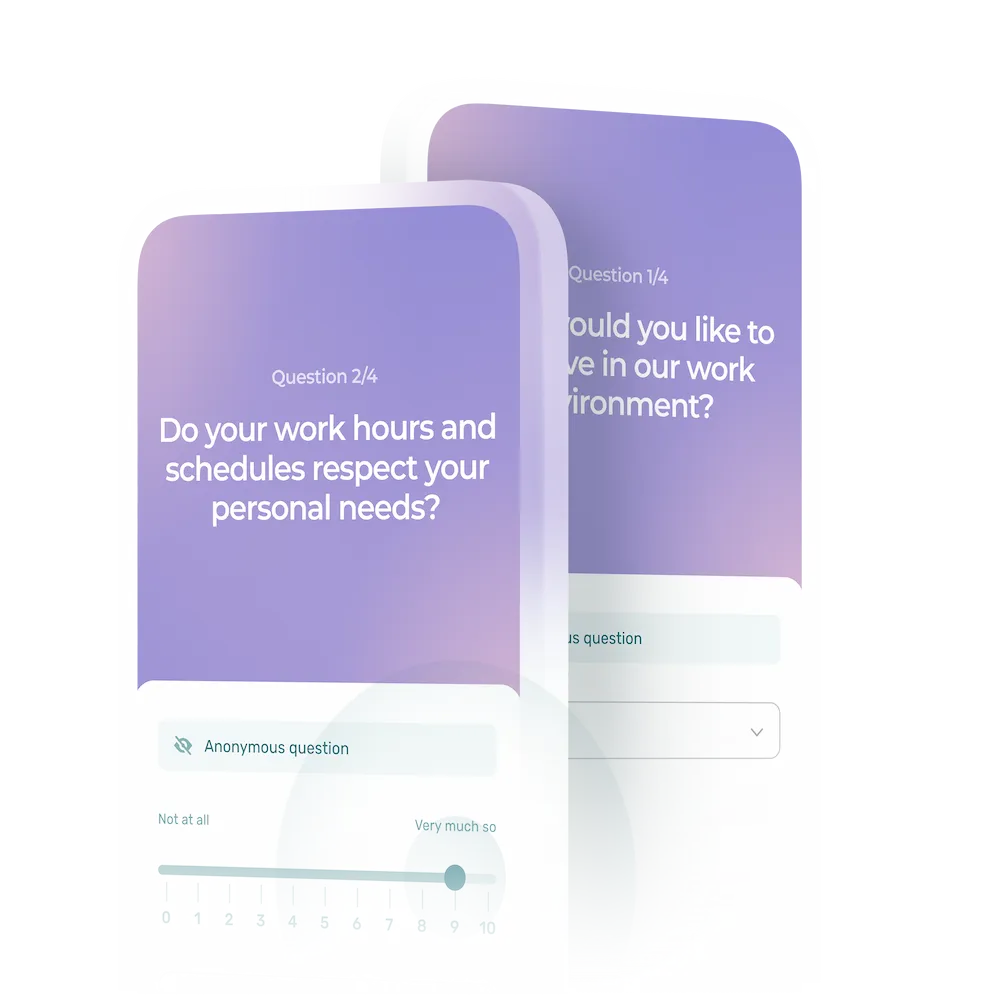Employee Pulse Survey: What It Is & 18 Crucial Questions to Measure Feedback
A growing number of businesses use employee pulse surveys to track engagement levels of their workforce.
Learn exactly what an employee pulse survey is and how often you should distribute these short questionnaires. See what questions pulse surveys should contain, and how to use the collected data to improve business performance.
What Is an Employee Pulse Survey?
Just as the name suggests, an employee pulse survey (sometimes referred to as “pulsing” or a “pulse check survey”) collects real-time employee feedback on specific work-related topics, such as job satisfaction and engagement levels.
Pulse surveys are commonly included in effective employee retention strategies. These short questionnaires are designed to be distributed on a regular basis (weekly, bi-weekly or monthly) over a specific timeframe to closely track changes in employee sentiment on a given issue. A staff pulse survey generally contains the same short set of questions.
Used right, a good pulse survey can be an effective employee management tool and significantly improve employee retention and the employee experience.
Unlike the much more lengthy annual engagement surveys that cover a wide range of topics relating to engagement, pulse surveys are a quick and easy way for organizations and HR managers to continuously collect employee feedback in real-time.
These timely insights can be especially helpful in determining the impact new initiatives or changes are currently having on employees—or if any immediate adjustments are required before employee retention rates take a hit.
Types of Employee Pulse Surveys
An employee pulse survey can take on various forms. Here are just 4 types of employee pulse surveys that can be used to closely track employee sentiment over a specific period of time.
1. Onboarding Experience Pulse Survey
Research shows that offering a great onboarding experience can improve the retention of new hires by 82%. It also shows that it can take up to three months to fully onboard a new hire. Even longer, in some instances. A lot can happen during this time that might cause new hires to have second thoughts about sticking with their new job.
Sending new hires a weekly onboarding experience pulse survey during these first months can help you gauge if they are settling into their new roles or if extra attention is needed to help them engage fully with their new team and company.
Having this granular week-by-week data will also pinpoint any weak points in your employee onboarding program.
2. Remote Work Survey
The global pandemic triggered a massive shift to remote working. Remote and hybrid work models have since become commonplace in many industries such as healthcare, and offices and call centers.
Many employees appreciate being able to work from home. But not all share this sentiment.
Remote and hybrid working brings its own challenges, such as instilling the corporate culture and a sense of team spirit.
Using a remote or hybrid work survey will let you identify issues employees may be struggling with.
3. Merger and Acquisition Pulse Surveys
Mergers and acquisitions are always cause for concern for employees. What’s going to change? What’s staying the same? Will they lose their job?
As many as one in four top performing employees leave an organization following a major organizational change such as a merger or acquisition, even if their current job is secure.
Distributing a bi-weekly M&A pulse survey will let you gauge employee sentiment and engagement throughout the entire process and in the weeks and months that follow.
This timely data can be used to minimize employee turnover or decreased performance. These types of risks can be especially damaging in labor-intensive industries like retirement homes and hotels and hospitality.
4. Diversity & Inclusion Pulse Survey
A growing number of businesses are adopting diversity & inclusion initiatives. But not all are closely tracking outcomes, including impacts on their existing workforce.
Waiting until your annual employee engagement survey comes around to gauge the effectiveness of your diversity & inclusion program can lead to lost opportunities.
A regular pulse survey on diversity & inclusion will let you know if your efforts are bearing fruit or if changes are needed. Developing diversity can be especially beneficial in industries like retail and call centers.
Annual Surveys vs Pulse Surveys
Annual engagement surveys are distributed only once a year. They generally contain a long list of questions and are designed to present a full “snapshot” of employee engagement for the year. These survey results are often used as fodder for the company’s annual report.
Pulse surveys are much shorter—normally only a few questions at most. As a result, they can be distributed more regularly to obtain a reliable and repeated measure of employee sentiment, with much less risk of survey fatigue.
Pulse Surveys vs Engagement Surveys
Both pulse and engagement surveys can be used to measure employee engagement metrics like sentiment toward the company culture, workplace satisfaction, and sense of fulfillment at work.
However, an employee engagement survey is much more comprehensive. It will often address a wide range of issues, such as:
- Job duties and expectations
- Work-life balance
- Support from management and fellow teammates
- Benefits
- Inclusivity and fairness
- Workplace culture
- Opportunities for growth
- Communication
Given their length, employee engagement surveys are usually distributed only once or twice a year.
In contrast, a pulse survey will generally measure one metric only—such as job satisfaction–and ask a few highly targeted questions on this specific issue.
Benefits of Using Pulse Surveys
1. Measure the Effectiveness of Initiatives
Take this real-life example involving change management.
Your recent annual engagement survey showed that employees wanted better communication between different teams within the organization. So you implemented a new internal communication plan and digital tools to facilitate communication and collaboration.
Rather than waiting for next year’s engagement survey to gauge employee satisfaction with these initiatives, you could send out pulse surveys monthly to track changes in sentiment throughout the year.
Since change can initially take employees out of their comfort zone, a pulse survey can be a good way to see how well employees are adjusting to major changes within the organization over time.
2. Capture Trends & Understand Relationships
It can be nice to report a 80% employee satisfaction rate, but it doesn’t tell you what you’re doing right, what areas need improvement, or how this number has changed over the course of the year.
It especially doesn’t tell you if this number is strongly influenced by the introduction of a new initiative, such as a professional development program or flex hours.
A monthly pulse survey will make it easier to link dips and rises in employee sentiment to real-time events. A great way to track overall trends and to know if employees feel valued – or if resources are being used wisely.
3. Catch Issues Before They Turn Into Problems
Employee engagement can have a significant impact on customer satisfaction and therefore, business performance.
A bi-weekly pulse survey will tell you if the arrival of a new manager or work method is negatively impacting job satisfaction. More importantly, these surveys will shed light on the potential duration and severity of the impact. Consider it an early warning system to help you maintain and improve employee engagement.
It may be that employees are simply feeling the normal frustration that comes with learning a new work tool and having to change long-engained work habits. Or perhaps it’s a more serious long-term issue like a drastic change in corporate culture being ushered in by a new executive team.
Each consecutive pulse survey will tell you which way the trend is headed.
4. Collect More Reliable Data
Filling out long surveys is never fun—especially when there’s more important work to do. Internal surveys generally receive a 30-40% response rate on average.
A good response rate doesn’t necessarily mean reliable data, however.
Employees who feel pressured or obligated to fill out long surveys will often resort to practices like satisficing or straightlining to get the survey over with as quickly as possible. This can drastically skew your survey data.
- Satisficing: Giving only “satisfactory” answers to questions.
- Straightlining: Answering all questions the same way, such as selecting “Somewhat Agree” for every question.
See ways to avoid satisficing in your survey results.
Since pulse surveys are so short, employees are more likely to answer them honestly.
5. Avoid Survey Fatigue
Survey fatigue is a real phenomenon—but not necessarily for the suspected reasons.
Survey fatigue has less to do with the number of surveys employees are asked to fill out, and more to do with the perception that feedback is falling on deaf ears.
When using surveys of any kind, management must commit to using the results in decision-making and to communicating these decisions back to employees.
New to measuring employee satisfaction and not sure where to start? Download our Employee Satisfaction Survey Template to identify immediate areas for improvement.
What Can You Measure With Employee Pulse Surveys?
1. Engagement
Measure key drivers of employee engagement such as career progression or work-life balance.
2. Action Plans
Track progress of actions plans and identify elements that need to be corrected on-course.
3. Company Values
Ensure corporate values are being embraced by employees in their day-to-day. This can be especially useful in your employee onboarding program.
4. Change
Regularly check in with employees during major organizational changes such as a restructuring. This can be especially useful in your organizational change program.
5. Sense of Belonging
Measure levels of belonging and take necessary steps when spirits are lower or when you sense the air needs to be cleaned out. Why not arrange a team-building exercise to boost morale?
6. Mental Health
Check-in to make sure your employees’ stress levels are under control. Don’t forget to take necessary measures if you realize that the team has been under the weather lately.
7. Job Satisfaction
A good way to lower employee turnover is to make sure they are happy at work. An employee pulse survey is a great way to access your team’s level of satisfaction and to ask about happiness at work.
8. Training
If you offer training to your employees, make sure to survey them to see if the sessions are fruitful.
These are just a few topics that you can monitor with employee pulse surveys. But there is much more to it!
Employee Pulse Survey Best Practices
1. How Long Should a Pulse Survey Be?
The more often the survey is distributed, the shorter it should be. As a general rule:
- Weekly pulse: 2-3 questions
- Bi-weekly pulse: 5 questions
- Monthly pulse: 10 questions
- Quarterly pulse: 15 questions
- Bi-annual pulse: 30 questions
2. How Often to Run Employee Pulse Surveys
Pulse surveys can be distributed weekly, bi-weekly, monthly, quarterly or bi-annually. The ideal frequency will depend on:
- How often the business needs feedback on the metrics being measured
- How frequently these metrics are likely to fluctuate
- How often other organizational metrics are reported
- How quickly the business can process survey results
- How quickly the business can act on this feedback
3. How to Avoid Survey Fatigue
If the organization is serious about job satisfaction and employee engagement, the last thing the HR manager should do is expect employees to answer the same question over and over again.
If employees feel that pulse surveys are not leading to meaningful recognition and positive change, they will stop taking them seriously—or stop answering them altogether.
4. How to Get Started With Pulse Surveys
Start by creating a strategy. Identify areas with potential issues, then decide exactly what feedback that company needs to know. Also decide what it will do with this feedback.
Details like survey frequency and the specific questions to ask will flow from there. The key is to frame questions in a way that will elicit actionable responses.
Pulse survey software can make it easier to create complete pulse surveys.
Pulse Survey Question Structure
18 High-Impact Employee Pulse Survey Questions
1. Questions About the Work Environment
- What improvements could be made to our work environment?
- What do you like most/least about our corporate culture?
- What could be improved in the way we do things [add an example of a task]?
- Can you name a bothersome/unpleasant situation that has occurred in the past few months?
- How does the current work climate positively or negatively impact your daily life?
- On a scale of 1 to 10, how likely would you be to recommend to a friend that they come work for us?
2. Feedback on Working Conditions
- What information or resources are you lacking to be more effective?
- Do you feel you have enough control over your own work schedule?
- Are you happy overall with your current number of work hours each week?
- If you could change one thing about the relationships on the team, what would it be?
- Do you find that the company provides the necessary support to help you with your career development?
- What do you like most about working for us?
Looking for ways to give employees more control over their work schedules to improve job satisfaction? Download our Free employee availability form
3. Questions About Onboarding
- On a scale of 1 to 10, how satisfied are you with your experience as a new employee?
- What could we do better to ease your transition into the job?
- Have you received all the necessary training to perform your tasks?
- How have things been with your welcome to the team?
- How satisfied are you with your work environment so far?
- Do you have any questions about your role? Have you had the opportunity to discuss this with your supervisor?
Conclusion
Collecting honest feedback from employees is a first essential step in improving employee engagement. The next level is translating this frequent feedback into action. Only this will truly lead to better employee retention rates, team productivity, and business performance.
When used properly, pulse surveys will lead to smarter, more timely decision-making and potentially, a stronger organization.
What Should I Ask In a Pulse Survey?
Employee pulse surveys can address a variety of issues such as:
- Employee engagement
- Work-life balance
- Onboarding and training
- Professional development opportunities
- Change management
- New initiatives
- Diversity and inclusion
- Employee benefits
- Leadership accountability and manager effectiveness
- Corporate social responsibility
How Do You Write a Pulse Check Survey?
- Use broad questions that will apply to all respondents. This will make employees less likely to skip them or answer untruthfully.
- Include at least one open-ended and one closed-ended question. A smart practice is to lead with a closed-ended question and then follow up with an open-ended question to confirm responses and collect more relevant feedback.
Focus on questions that produce easily measurable results and that can lead to direct improvements such as Net Promoter Score.











